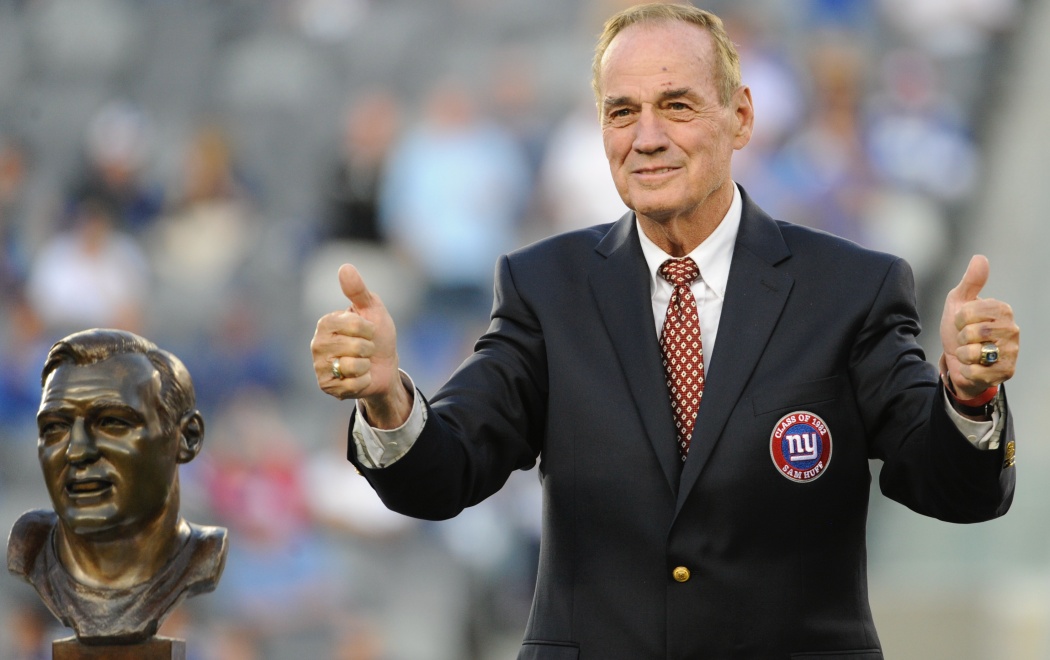Gold Jacket Spotlight: Sam Huff, From Coal Mines to Big Apple

Twice during Sam Huff’s relatively short Enshrinement speech, the newest member of the Pro Football Hall of Fame’s Class of 1982 referred to himself and his family as the “pick-and-shovel group.”
For someone born in Edna Gas, W.Va., who expected to join others from the hills of the Appalachian Mountains into the coal mines, the words carried significant meaning.
“My dad worked in the mines, my brothers worked in the mines, my uncles worked in the mines. I said, ‘I don’t want to do that,’” Sam said many years after his career ended.
Fate and football intervened – leading him to a future with the National Football League rather than at his hometown’s “No. 9 coal camp.”
Still, Sam never abandoned his roots nor forgot the tough, working-class upbringing he would call on to help define his style of play at middle linebacker in the 1950s and 1960s in New York and Washington.
This week, Sam steps into the Gold Jacket Spotlight.
With his athleticism and instincts, Sam flourished in the 4-3 alignment Tom Landry installed in with the Giants as defensive coordinator. He was the league’s outstanding rookie in 1956, after joining the team as a third-round pick out of West Virginia, where he was an All-American and Academic All-American. He helped the Giants to an 8-3-1 regular-season record and the NFL Championship Game, which ended in a 47-7 rout of the Chicago Bears.
Sam played every game over the next seven years as the Giants made five more appearances in the playoffs, including the 1958 championship, the “Greatest Game Ever Played.” He was the vocal and physical leader of a team laden with future Hall of Famers.
In 1959, Sam graced the cover of Time magazine – the first NFL player to do so. A year later, he was “mic’ed up” with a transistor radio to capture the sounds of the game for a program titled, “The Violent World of Sam Huff.” He appeared in several newspaper and magazine ads as a spokesman for clothing and various products.
New York loved Sam, and Sam loved New York.
The love affair ended after eight years, however, with his stunning trade to Washington.
“I didn't want to be traded from a championship team, a championship organization,” he admitted in an interview. He didn’t report to Washington for several weeks.
Washington was considered inferior, but Sam eventually came on board and played the only way he knew how: full throttle. The defense improved to among the league’s best in short order, and in his last season – 1969 – the team posted a 7-5-2 record to end a string of 13 years without a winning record.
Sam finished his career with 30 interceptions – at least one in each of his 13 seasons – and 17 fumble recoveries.
He was named All-Pro twice and selected to play in five Pro Bowls – winning the MVP award of the 1961 game. He is a member of the NFL’s All-Decade Team of the 1950s.
“I always feel real good when I hit someone,” Sam once said on camera.
Clearly, he felt good a lot.
And the Pro Football Hall of Fame feels good putting Sam and his career back in the Spotlight.
The Mission: 'Road to Canton' feat. Torry Holt
Pro Football Hall of Fame Class of 2021 Finalist, Torry Holt, was the latest guest on The Mission.
The Mission: 'Road to Canton' feat. LeRoy Butler
Pro Football Hall of Fame Class of 2021 Finalist, LeRoy Butler, was the latest guest on The Mission.

